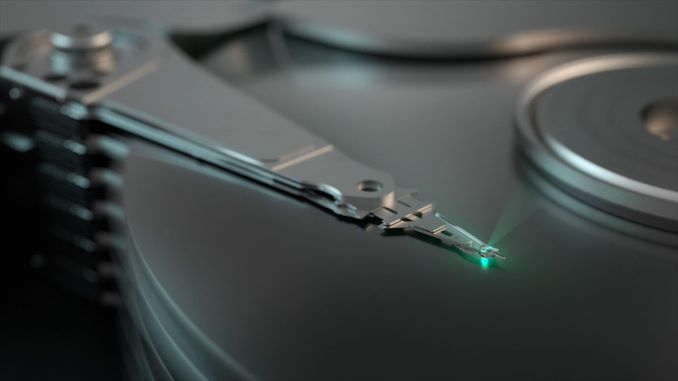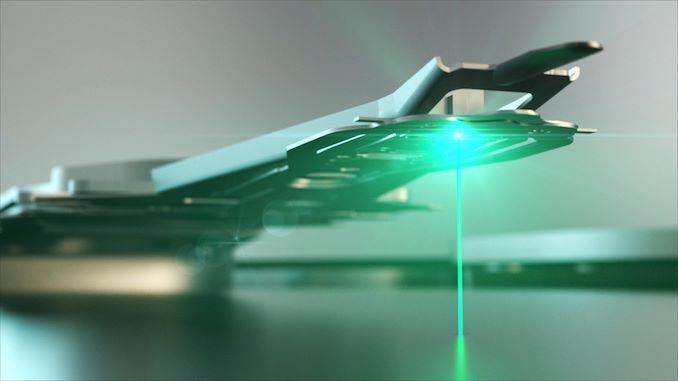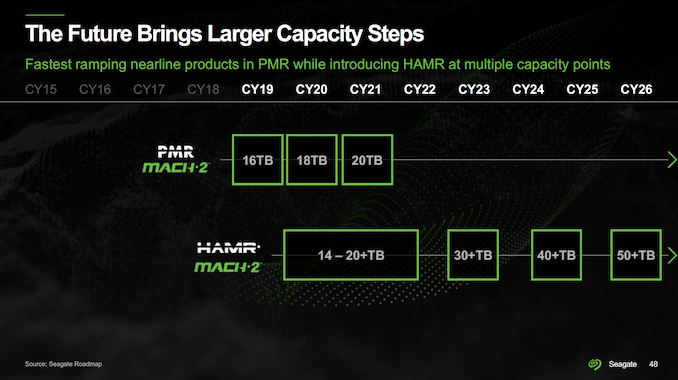Seagate Confirms 30TB+ HAMR HDDs in Q3, Envisions 50TB Drives in a Few Years
by Anton Shilov on January 27, 2023 6:00 PM EST
Seagate this week confirmed plans to launch the industry's first 30+ TB hard drive that uses its heat assisted magnetic recording (HAMR) technology, as well as reaffirming its commitment to release HDDs with capacities of 50 TB and higher in a few years. But before this happens, the company will release 22 TB and 24 TB HDDs that will rely on perpendicular magnetic recording (PMR) and shingled magnetic recording (SMR) technologies, respectively.
One More Play for PMR and SMR
Various energy assisted magnetic recording methods, such as HAMR, will be used for next generations of hard drives for years to come. But while PMR is running out of steam, it is still evolving. Seagate has managed to increase areal density enabled by its PMR + TDMR platform by around 10%, enabling 2.2 TB 3.5-inch HDD platters and thus 22 TB hard drives featuring 10 of such disks. Furthermore, by using shingled recording, these drives can have their capacity stretched to 24 TB.
These 22 TB and 24 TB Seagate Exos drives will likely be drop-in compatible with existing cloud datacenter hardware as well as infrastructure, and should not require extensive validation and certification procedures, unlike brand-new HAMR HDDs. As a result, Seagate's customers will be able to deploy such hard drives fairly quickly and increase storage density and storage capacity of their datacenters.
Seagate is now ramping up production of its 22 TB hard drives for datacenters, so expect the company to start their shipments shortly. Seagate is not disclosing when exactly it will officially launch its 22 TB and 24 TB parts, but we would expect them to arrive before the company introduces its HAMR-based HDDs; so think Q1 or Q2.
30+ TB HDDs Coming in Q3
In fact, Seagate has been shipping HAMR HDDs to select customers for evaluation as well as inside its own Lyve storage systems for a while, but those drives featured capacities akin to those of PMR/CMR HDDs and were not available in huge volumes. With Seagate's 2nd generation HAMR platform, the company is going after higher volumes, but it took the company quite some time to get there. The first pre-qualification high-capacity HAMR-based HDDs are only just now getting ready to head out to customers for evaluation.
"We are meeting or exceeding all product development milestones and reliability metrics, and we will be shipping pre-qualification units to key cloud customers in the coming weeks," said Dave Mosley, chief executive of Seagate.
Meanwhile, commercial HAMR hard drives with capacities of 30TB or higher will ship in third quarter of this year, which is in-line with what Seagate promised last year.
"As a result of this progress, we now expect to launch our 30-plus terabyte platform in the June quarter, slightly ahead of schedule," said Mosley. "The speed of the initial HAMR volume ramp will depend on a number of factors, including product yields and customer qualification timelines."
Initially Seagate will only offer its HAMR technology for its highest-capacity offerings for hyperscale datacenters, whom need maximum storage density and are willing to pay premium for the drives and for supporting infrastructure. As yields of HAMR-supporting media and the appropriate read/write heads increase, the technology will be applied for drives with lower capacities in a bid to cut down their production costs (fewer disks and heads, lower the costs). This is not going to happen overnight though, as the company needs to increase yields of HAMR drive components and the HDDs themselves to a comfortable level.
"I think this year, [the volume of HAMR HDDs] will probably still be relatively low," said the head of Seagate. "Then the faster we can get the yields and scrap and all the costs that we can control down on the heads and media, then the faster we'll be accelerating. I think that will happen in calendar year 2024 and calendar year 2025 will just continue to accelerate. The highest capacity points will be addressed, but also these midrange capacity points."
50+ TB HDDs Will Be Here in a Few Years
Seagate's launch of its first mass market 30+ TB HAMR hard drives platform will mark a milestone for the company and the whole industry. But apparently the company has another breakthrough to share at this time. The firm said this week that it had created 5 TB platters for 3.5-inch hard drives, which presumably entails new media, new write heads, and new read heads.
"It was nearly four years ago to the day that I first shared our lab results demonstrating 3 TB per disk capacities," explained Mosley. "And today, we have demonstrated capacities of 5 TB per disk in our recording physics labs."
For now, these platters are used on spinstands for evaluation and testing purposes, but platters like these will allow for 50 TB HDDs a few years down the line. Seagate's roadmap indicates that such hard drives will hit the market sometimes in calendar 2026.
It is unclear how thin the new platters are. But following current trends of nearline HDD evolution — increasing areal density and increasing number of platters per hard drive — it's not outside the realm of possibility that Seagate will find ways to integrate even more than 10 platters in future drives. In which case Seagate would be able to hit drive sizes even larger than 50 TB.
In any case, with ~3 TB platters in production, samples of ~30 TB HDDs shipping to customers, and 5 TB platters demonstrated in the lab, Seagate's HAMR roadmap seems to look quite solid. Therefore, expect hard drives to gain capacities rapidly in the coming years.












70 Comments
View All Comments
Marko123 - Monday, January 30, 2023 - link
Completely irrelevant statistics at large scale. HDDs are being deployed now in large CSPs to replace tape storage. Archival is the cheapest of all media. SSDs make no sense there.Samus - Monday, January 30, 2023 - link
I love when people link to Backblaze who, for a solid decade, has continued releasing uncredible, extremely bias reports on their hard disk data using flawed testing methodology and irrelevant metrics. They are the backyard mechanic of data storage and anybody who uses them is seriously clueless. They literally shucked drives for their redneck drive pods. Real data centers don't use SSD's for storage or archive. They find their application in caching and OS dependency.Arnham - Friday, March 10, 2023 - link
"Real data centers don't use SSD's for storage or archive"guess that makes backblaze a real data center then, because their SSDs are only used for boot/OS drives...
Can you elaborate on your criticisms of backblaze, what exactly is your issue with their methodology and bias?
They shucked drives during the great hard drive shortage when all the HDD factories got flooded, way back in 2011. External hard drives were still widely available, but internal ones were not. I myself shucked a few around then due to the shortage.
TheinsanegamerN - Tuesday, January 31, 2023 - link
Maybe cool down your whataboutism until you learn what reading comprehension is?Reflex - Monday, January 30, 2023 - link
There is no practical limit on 'program/erase' for magnetic disks, that is why it's not mentioned in the press releases or the technical literature. HDD's are measured by MTBF, a measure of estimated reliability, you can find more information here: https://en.wikipedia.org/wiki/Mean_time_between_fa...On magnetic disks there is no write/erase cycle because old data is not 'erased', it is simply overwritten by new data and neither process produces any wear on the platter as it's done magnetically. The failure points are typically in the motor or if vibration dampening is not adequate. In a hypothetically perfect environment they'd last longer than a human lifetime.
Marko123 - Monday, January 30, 2023 - link
HAMR drives will likely have a write endurance, unlike PMR. It won't be an SSD type endurance where the location matters (media wear out), but rather the total write head power on hours.Reflex - Tuesday, January 31, 2023 - link
I mean sure in the sense that mechanical parts wear down over time, but it's not program/erase cycles and we already have similar for MTBF for measuring the motors.The Von Matrices - Tuesday, January 31, 2023 - link
You must not be familiar with HAMR. The heating/cooling cycling of HAMR causes wear on the media unlike conventional hard drives.Reflex - Wednesday, February 1, 2023 - link
I am familiar with HAMR. So far I have seen no information that indicates the heating/cooling cycle wears faster than what MTBF allows, making such a metric useless as the one that matters is the one that will fail first.Secondly, if you understood HAMR you wouldn't say "program/erase cycles" since that is literally NAND terminology that has nothing to do with how magnetic media works and as such will never be a metric used.
flyingpants265 - Monday, January 30, 2023 - link
Drives can hit 50tb right now without any extra technology. They'd just need to be bigger. Also, they can turn at 1000rpm for all I care. You could even engineer them to fit together like Lego blocks so there is no wasted space, this would work if they're off most of the time.